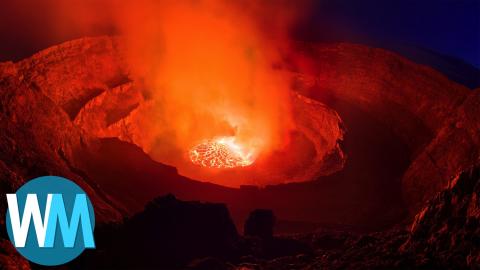Top 10 Volcanoes That Are Ready To Blow

For more great content from Getty Images, check out their Instagram page here: https://www.instagram.com/gettyimages/
These volcanoes may have had deadly eruptions in the past, but some scientists believe that the sleeping giants are still dangerous and could explode in the near future! WatchMojo presents the Top 10 Volcanoes That Are Ready to Erupt! But what will take the top spot on our list? Mount Vesuvius in Italy, Sakurajima in Japan, or Lake Ilopango in Indonesia? Watch to find out!
Watch on WatchMojo: http://www.WatchMojo.com
To vote for what video we should make next, check out our suggest page here: http://www.WatchMojo.commy/suggest.php
#10: Taal The Philippines
Don’t let its picturesque beauty fool you! Taal is historically one of the most active volcanoes in the Philippines. In fact, there have been 33 recorded eruptions in the past 500 years. However, what has scientists most worried is the giant’s recent activity. After rumblings started in 2008, authorities in the Philippines began monitoring the volcano closely for any indications that it could erupt. All the signs are there and warnings are regularly issued, so some believe it’s just a matter of time!
#9: Katla Iceland
Iceland is one of the most active volcanic hotspots in the world. In 2010, the eruption of Eyjafjallajökull made headlines when ash clouds disrupted European air travel. But the larger and more dangerous Katla might be the one to worry about now. Since the year 934 AD, Katla has erupted 20 times, and at relatively short intervals. It last blew in 1918, and recent tremors could be a sign that it’s ready to blow again. What’s more, a major eruption would melt the glacial ice in the caldera, causing massive floods.
#8: Galeras Colombia
Looming over the city of Pasto, the colossal Galeras erupts with alarming frequency. Galeras is Colombia’s most active volcano and it’s estimated that it’s been active for at least a million years. In 1993, an eruption killed six scientists and three tourists who had ventured into the volcano’s crater. In 2010, another eruption forced the evacuation of 8,000 people living in the volcano’s shadow. Recently, eruptions have become even more frequent, sometimes occurring multiple times a year. This is one volcano that’s pretty much always ready to blow.
#7: Mount Nyiragongo Democratic Republic of Congo
Top 10 Creepiest Mount Everest Mysteries
With its massive lava lake, Nyiragongo has become an attraction for sightseers and scientists. But the lake also makes the volcano particularly dangerous. You see, the lava in the lake is unique in that it’s unusually fluid and fast-moving. When the crater cracked in 1977, lava flows ran down the flanks of the volcano at speeds of up to 40 miles per hour, killing approximately 70 people. In 2002, the lake drained out through new fissures, destroying thousands of buildings in nearby Goma. Since then, a new lake has formed, as has a new side vent, sparking fears of an eruption in the near future.
#6: Popocatépetl Mexico
This giant stratovolcano, whose name means “smoking mountain,” was once crowned with thick ice. But the volcano’s glaciers have disappeared, due in part to a recent increase in volcanic activity. Mexico’s most active volcano, “El Popo” has erupted 15 times in the last 500 years. After slumbering for decades, it became active again in 1994, and has been spewing rocks and plumes of ash on and off ever since. So far, these eruptions have been small, but Popocatépetl has had larger eruptions in the past, and its activity is being closely monitored.
#5: Mount Paektu North Korea / China
Tough Rides: China, Episode 5: Mount Everest and Lhasa
Located atop Mount Paektu on the border of China and North Korea, the idyllic Heaven Lake hides a violent past. The lake sits in a caldera formed by one of the three largest eruptions in the last 5,000 years: occurring in 946 AD, it rated 7 out of 8 on the Volcanic Explosivity Index. The explosion also hurled ash as far as northern Japan and may have even altered China’s climate. Heaven Lake is rumored to be home to the legendary Lake Tianchi Monster, but it’s what’s below that worries some experts. Mount Baekdu erupted in 1668, 1702, and 1903, and could be due to blow again soon.
#4: Mount Merapi Indonesia
The smoke from Mount Merapi, the most active volcano in Indonesia, is said to come from two ancient armorers buried by the gods beneath the mountain. Locals bring annual offerings to appease the mountain, which is located close to densely populated Yogyakarta city, but a volatile magma chamber below fuels near regular eruptions. In 1930, pyroclastic flows – or burning clouds of gas and rocks - killed approximately 1400 people. More recently, in 2010, a series of eruptions disgorged ash, lava, and gases that killed 353 people and displaced thousands.
#3: Lake Ilopango El Salvador
You wouldn’t know it now, but tranquil Lake Ilopango is the site of one of the most devastating natural disasters in human history. In approximately 535AD, an eruption rated 6 on the Volcanic Explosivity Index blanketed the country in tephra, and is thought to have thrown up a veil of dust that plunged the world into volcanic winter and caused crop failure across the globe. A lava dome from the most recent eruption in 1879 created new islets in the lake, but since then magma has built back up. Researchers from the University of Bristol concluded in 2016 that the volcano poses a serious threat to the nearby capital, San Salvador city.
#2: Mount Vesuvius Italy
The eruption of Vesuvius in 79 AD, which killed well over a thousand people and buried the cities of Pompeii and Herculaneum, has made it perhaps the most famous volcano in the world. More recently, scientists have also worried about volcanic activity at Campi Flegrei and the undersea volcano Marsili, but the frequency and violence of Vesuvius’ explosive eruptions make it particularly dangerous. Since 1631, Vesuvius has been regularly active, with eruptions every few years until 1944. Civil authorities have an evacuation plan in place for the next eruption, seeing as how Vesuvius towers over Naples - a city with a population of over three million.
#1: Sakurajima Japan
Sakurajima has been raining ash down on residents in the surrounds since 1955. In 1914, a massive eruption connected the island to the mainland with lava flows. Japanese authorities have issued a level three out of five volcano alert, and in 2016 researchers warned of a major eruption within the next 30 years. A huge amount of magma has built up in the chambers beneath the Sakurajima, meaning that the next eruption could be explosive and devastating for residents living around the volcano.



